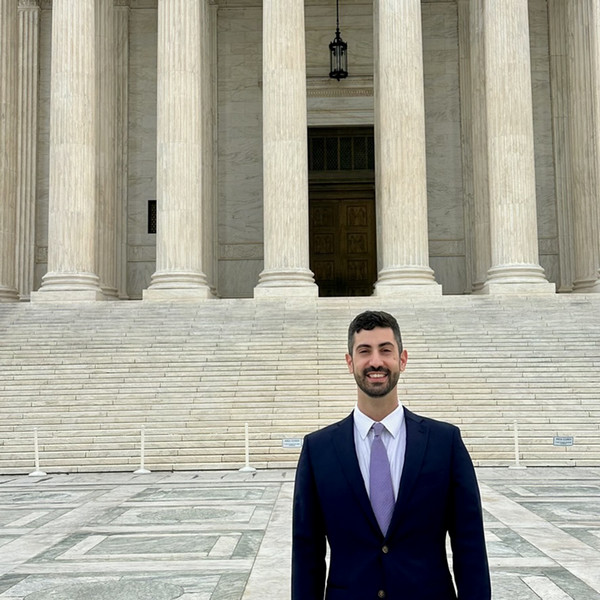A Senior Looks into the Real Story of Climate Migrants
By Rebecca Goldfine
"There is no real governance or policy to deal with climate-induced migration. But there needs to be, and that has really driven me and motivated me to work on this project," he said recently.
Vemulapalli focused on two case studies—in Bangladesh and in Tuvalu, an independent island archipelago in the South Pacific—to better understand the climate-related circumstances that can force people from their homes, and the kind of domestic and international responses that might best aid them.
"The comparison will involve looking at how climate change has interacted with the underlying drivers of migration to see what the commonalities between the two cases are, and if any policy recommendations can be made from the results," he writes in his thesis.
His advisor, Associate Professor of Government Laura Henry, said Vemulapalli is doing important work on climate migrants, "an issue of growing concern that has so far generated more speculation than scholarship."
"Tharun's interdisciplinary approach examines the slow- and rapid-onset changes to the environment that can cause migration, as well as the political, economic, and social factors that shape people’s decisions about whether to leave their home, their region, or even their country," Henry said. "Given that migration is such a contentious issue today, Tharun’s research points to important policy options related to making governance more effective and helping people adapt where they are so that migration is not their only option."
A few of Tharun's favorite classes
Introduction to Middle Eastern Religions, Robert Morrison, George Lincoln Skolfield, Jr. Professor of Religion
"I had never been introduced to religion as an academic topic, and it was illuminating to think about how religion plays a part in forming a society."
North American Indian History, c. 1450-1814, Strother Roberts, assistant professor of history
"This course introduced me to a topic that I had only been peripherally aware of but is integral to American history. Native American history is often written over, but we not only learned about it but also looked at how it applies to modern society. It forced me to grapple with these topics."
Contemporary Arctic Environmental and Cultural Issues, Susan Kaplan, professor of anthropology
"This class covered how the history of Inuits connects with how they're grappling with social and environmental issues today."
Why and how people leave
Before recommending ways to manage climate-induced migration, Vemulapalli examined this issue through the filters of Bangladesh and Tuvalu's economic conditions, government structures, and sociocultural factors. Both nations are vulnerable to climate change, but their futures will likely be very different.
Vemulapalli notes that internal migration has been relatively common in Bangladesh, as people are accustomed to moving seasonally to avoid monsoons, flooding, or tropical storms. And as environmental stresses increase, people in rural areas are also increasingly leaving failing farmlands for work in cities.
Personal relationships tend to direct where these migrants go, as Bangladeshi social connections and family serve as safety nets. Consequently, while Bangladeshis are reluctant to leave their homes, Vemulapalli cites research in which some also express their resolve to do so if it becomes necessary to survive.
However, for an island nation like Tuvalu, people don't have an obvious place to go if they lose their land and homes to sea surge and erosion, or when their land becomes saturated with salt. At the moment, Fiji and New Zealand have offered refuge to people from Tuvalu if and when climate change makes life on the island untenable. "But they have a unique cultural history they wouldn't want to give up," Vemulapalli said.
Policies that can help
A successful domestic policy for helping climate migrants would have the following features, according to Vemulapalli: it identifies the areas most in jeopardy and make those regions more resilient to climate change. If those regions can't be adapted to cllimate change, the policy would designate a place for refugees to resettle. An important consideration in this resettlement plan, his research suggests, is that the new location be conducive to rebuilding livelihoods and maintaining traditional values.
"You can make people even more vulnerable if you don't address all those things," he said.
International climate-change policies for refugees, if they are ever formed, could build on current aid structures, Vemulapalli posited in an interview. But it is difficult to define what exactly a climate refugee is, he added, since people have, throughout history, moved during droughts or when crops fail. "There is no framework for climate refugees as there is for political refugees," he explained. Identifying a person or family as a climate change refugee "is not quite as clearcut as being discriminated against."
Next year, Vemulapalli, an environmental studies and government major from Chicago, wants to work as a field organizer for a presidential campaign, perhaps for Kamala Harris, before going to law school or graduate school. "I want to stay involved in our democracy and see what I can do," he said.



